
Controls & Transformers
Questions and Answers
This question describes a classic case of introducing magnetic material into the throat of an AC welder. As magnetic material enters the throat it causes the impedance to increase which absorbs energy and the weld current will decrease. This decreasing current will result in smaller weld nuggets. To counteract this one has the option of using a constant current control or use different schedules for the different welds. Impedance is not an issue for nonmagnetic materials or when using DC or MFDC welders.
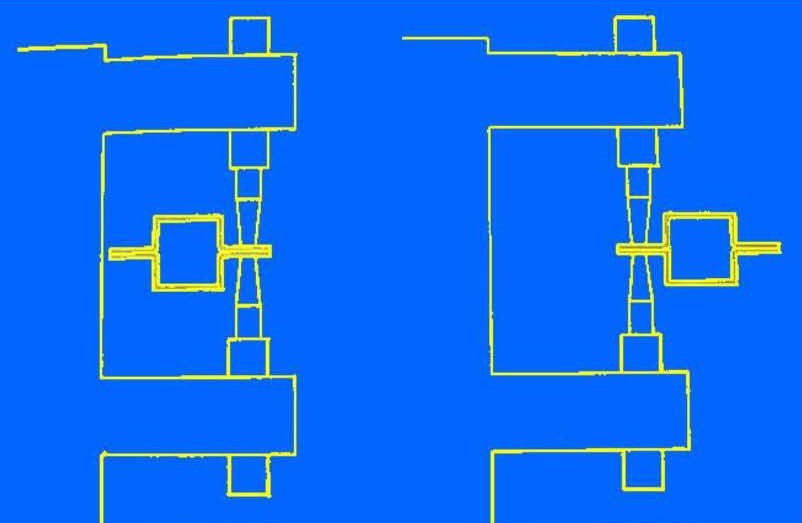
MAGNETIC METAL IN THE AC THROAT AREA INCREASES
IMPEDANCE WHICH WILL DECREASE CURRENT
All resistance welders consist of potentially four components that may require water cooling. They are the control, the transformer, the conductors and the electrodes with their copper holders. Machine or press welders have all of these components. Suspended hanging guns are similar but may use kickless cable for the conductors. Kickless cables are water cooled cables. Robotic applications generally use transguns which eliminate cooling the conductors but the mounting pads are cooled. In the case of seam welding, additional water may be sprayed directly on the workpiece and weld wheel at the weld zone to cool it down.
All cooling recommendations are for the machine and equipment longevity regardless of what material is being welded. In some specialty cases sensitivity to quenching of the workpiece might dictate a slower cool or special heat treatment. Slower cool can be obtained with a down slope at the end of the cycle. In other materials (i.e. Carbon content >0.4%) you may also need a Quench and Temper added to the weld schedule to maintain weld integrity.
Depending upon your system, an input and output water manifold would be assembled similar to the one shown below. The output and input water lines would be routed to the components that require water cooling. The plant water supply would be connected to the supply side of the manifold. This could be city water, plant water tower system or a chiller. The return would connect to a sewer drain, water tower return or chiller return.
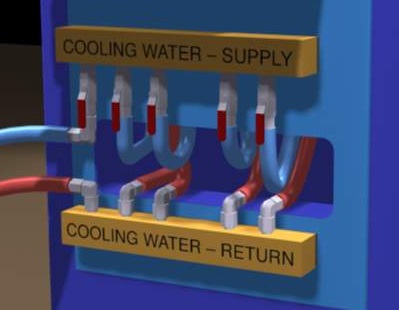
WATER MANIFOLD
Weld pulses are frequently used to grow the size of weld nuggets without overheating the part. In most cases the pulses are a repeat of the initial weld sequence with a very short one or two cycle cool between sequences. The diagram below depicts this type of sequence.
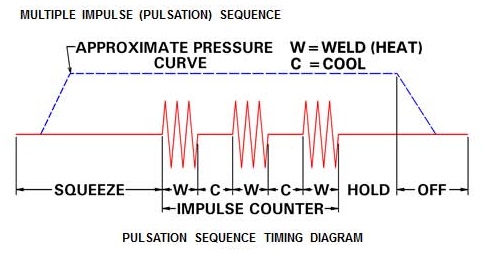
The chiller is definitely the proper choice. It’s recirculating water will be routed directly into the internal secondary circuit conductors and the attachment pads on the transformer face. These components carry the high currents and are subject to the most heating.
A fan can only cool the outside transformer surface or cooling fins attached to the outside surface. This would be very inefficient and leave the internal secondary components subjects to heat buildup and possible failure.
Cooling water is critical for all major components of a resistance welder.

Water Manifold
City water or recirculating water from a water tower along with a chiller are acceptable for cooling a resistance welder and its components. All of the water systems are preferred over a fan since they will directly cool the desired component.
MFDC stands for MID FREQUENCY DIRECT CURRENT. Three phase AC @ 60 hertz input is converted to a high frequency 400-4000 Hz input to the transformer. The transformer then produces a DC output to the welder.
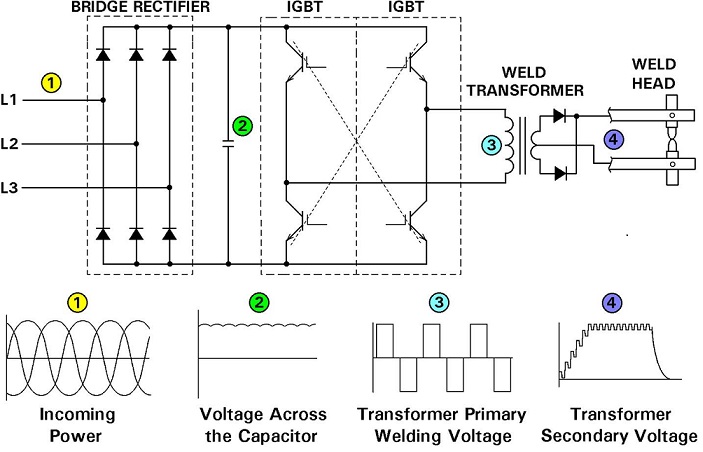
SCHEMATIC AND POWER CONVERSION IN CONTROL AND TRANSFORMER OF MID FREQUENCY INVERTER
AC stands for alternating current. Historically in North America the standard welding controls have been single phase AC @ 60 Hz input. The transformer produces a low voltage high amperage AC output at 60 Hz suitable to produce the desired welding parameters. The Typical AC sine wave outputs would look like those shown below.
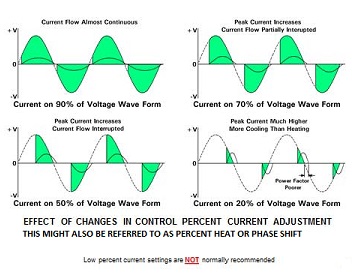
Each time the sine wave crosses zero the AC weld actually cools momentarily. Additional cooling occurs depending upon the amount of phase shift as shown above. As the heating accumulates the part heats up. AC equipment is very robust and can last a lifetime if properly cooled and operated within its rated capability.
MFDC is timed in milliseconds (ms). There are 16 ms in one 60 Hz AC sine wave. Because MFDC heats continuously, DC actually can produce the same amount of heat of one AC sine wave in much less time as demonstrated below:
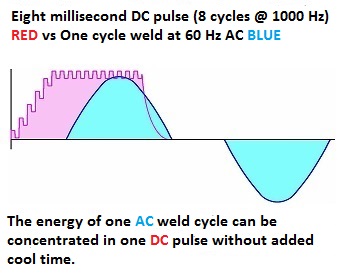
This attribute of heating without a zero cross over and no phase shift allows MFDC to heat quickly. Another feature is that inductive losses are nearly eliminated with DC. Therefor MFDC transformers can heat the parts with less power. Additionally MFDC transformers are operated at higher frequency’s which allows them to be made smaller. Smaller means less weight for a robot arm to carry.
MFDC has become the system of choice in the automation world. Timing in (ms) allows finer control of the process which can result in better process results.
Many applications are turning to MFDC because the process can:
Lower weight
It is fast
Reduce power requirements
Better resolution of heat control
Page 14 of 39
Have a Question?
Do you have a question that is not covered in our knowledgebase? Do you have questions regarding the above article? Click here to ask the professor.
